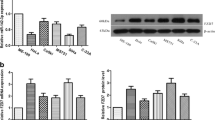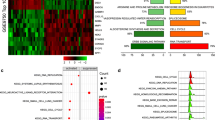Abstract
The exact expression profile and potential involvement of miR-625-5p in the tumor biology of cervical carcinoma are still elusive. In this study, we aimed to analyze the expression status and possible involvements of miR-625-5p in both clinical tissue samples and cell culture of cervical carcinoma. The relative expression levels of miR-625-5p and NF-κB transcript were determined by real-time polymerase chain reaction. Cell proliferation was measured using Cell Counting Kit-8. The protein levels of Cyclin D1, CDK4, NF-κB, and GAPDH were examined by Western blotting. The regulatory effects of miR-625-5p on NF-κB and MALAT1 were interrogated by luciferase reporter assay. We demonstrated that miR-625-5p was downregulated and predicted better survival in cervical carcinoma. Ectopic over-expression of miR-625-5p inhibited cell growth via targeting NF-κB. We further identified MALAT1 as the competitive endogenous long non-coding RNA for miR-625-5p, and over-expression of MALAT1 attenuated the inhibitory effect of miR-625-5p on NF-κB signaling in cervical carcinoma. Our study characterized the suppressive expression of miR-625-5p in cervical carcinoma and unraveled the importance of MALAT1/miR-625-5p/NF-κB signaling in this disease.





Similar content being viewed by others
References
Cohen, P. A., Jhingran, A., Oaknin, A., & Denny, L. (2019). Cervical cancer. Lancet, 393, 169–182. https://doi.org/10.1016/S0140-6736(18)32470-X.
Siegel, R., Naishadham, D., & Jemal, A. (2013). Cancer statistics. CA A Cancer Journal for Clinicians, 63, 11–30. https://doi.org/10.3322/caac.21166.
Schiffman, M., Castle, P. E., Jeronimo, J., Rodriguez, A. C., & Wacholder, S. (2007). Human papillomavirus and cervical cancer. Lancet, 370, 890–907. https://doi.org/10.1016/S0140-6736(07)61416-0.
Wang, Y., Yu, Y. H., Shen, K., Xiao, L., Luan, F., Mi, X. J., Zhang, X. M., Fu, L. H., Chen, A., & Huang, X. (2014). Cervical cancer screening and analysis of potential risk factors in 43,567 women in Zhongshan, China. Asian Pacific Journal of Cancer Prevention, 15, 671–676. https://doi.org/10.7314/apjcp.2014.15.2.671.
Perez, S., Zimet, G. D., Tatar, O., Stupiansky, N. W., Fisher, W. A., & Rosberger, Z. (2018). Human Papillomavirus vaccines: successes and future challenges. Drugs, 78, 1385–1396. https://doi.org/10.1007/s40265-018-0975-6.
Wipperman, J., Neil, T., & Williams, T. (2018). Cervical cancer: evaluation and management. American Family Physician, 97, 449–454.
Sun, P., Shen, Y., Gong, J. M., Zhou, L. L., Sheng, J. H., & Duan, F. J. (2017). A new microRNA expression signature for cervical cancer. International Journal of Gynecological Cancer, 27, 339–343. https://doi.org/10.1097/IGC.0000000000000863.
Su, H., Zou, D., Sun, Y., & Dai, Y. (2019). Hypoxia-associated circDENND2A promotes glioma aggressiveness by sponging miR-625-5p. Cellular and Molecular Biology Letters, 24, 24 https://doi.org/10.1186/s11658-019-0149-x.
Zhang, H., Feng, C., Zhang, M., Zeng, A., Si, L., Yu, N., & Bai, M. (2019). miR-625-5p/PKM2 negatively regulates melanoma glycolysis state. Journal of Cellular Biochemistry, 120, 2964–2972. https://doi.org/10.1002/jcb.26917.
Yuan, Y., Niu, F., Nolte, I. M., Koerts, J., de Jong, D., Rutgers, B., Osinga, J., Azkanaz, M., Terpstra, M., Bystrykh, L., Diepstra, A., Visser, L., Dzikiewicz-Krawczyk, A., Kok, K., Kluiver, J., & van den Berg, A. (2018). MicroRNA high throughput loss-of-function screening reveals an oncogenic role for miR-21-5p in Hodgkin Lymphoma. Cellular Physiology and Biochemistry, 49, 144–159. https://doi.org/10.1159/000492850.
Dong, X., Xu, M., Ren, Z., Gu, J., Lu, M., Lu, Q., & Zhong, N. (2016). Regulation of CBL and ESR1 expression by microRNA-223p, 513a-5p and 625-5p may impact the pathogenesis of dust mite-induced pediatric asthma. International Journal of Molecular Medicine, 38, 446–456. https://doi.org/10.3892/ijmm.2016.2634.
Cui, P., Su, J., Li, Q., Xu, G., & Zhu, N. (2019). LncRNA RHPN1-AS1 targeting miR-625/REG3A promotes cell proliferation and invasion of glioma cells. Onco Targets and Therapy, 12, 7911–7921. https://doi.org/10.2147/OTT.S209563.
Qian, F. H., Deng, X., Zhuang, Q. X., Wei, B., & Zheng, D. D. (2019). miR6255p suppresses inflammatory responses by targeting AKT2 in human bronchial epithelial cells. Molecular Medicine Reports, 19, 1951–1957. https://doi.org/10.3892/mmr.2019.9817.
Shen, F., Zheng, H., Zhou, L., Li, W., & Xu, X. (2019). Overexpression of MALAT1 contributes to cervical cancer progression by acting as a sponge of miR-429. Journal of Cellular Physiology, 234, 11219–11226. https://doi.org/10.1002/jcp.27772.
Yang, L., Bai, H. S., Deng, Y., & Fan, L. (2015). High MALAT1 expression predicts a poor prognosis of cervical cancer and promotes cancer cell growth and invasion. European Review for Medical and Pharmacological Sciences, 19, 3187–3193.
Wang, N., Hou, M. S., Zhan, Y., Shen, X. B., & Xue, H. Y. (2018). MALAT1 promotes cisplatin resistance in cervical cancer by activating the PI3K/AKT pathway. European Review for Medical and Pharmacological Sciences, 22, 7653–7659. https://doi.org/10.26355/eurrev_201811_16382.
Xia, C., Liang, S., He, Z., Zhu, X., Chen, R., & Chen, J. (2018). Metformin, a first-line drug for type 2 diabetes mellitus, disrupts the MALAT1/miR-142-3p sponge to decrease invasion and migration in cervical cancer cells. European Journal of Pharmacology, 830, 59–67. https://doi.org/10.1016/j.ejphar.2018.04.027.
Wang, Y., & Chen, Z. (2020). Mutation detection and molecular targeted tumor therapies. STEMedicine, 1, e11 https://doi.org/10.37175/stemedicine.v1i1.11.
Wu, D., Liu, J., Chen, J., He, H., Ma, H., & Lv, X. (2019). miR-449a suppresses tumor growth, migration, and invasion in non-small cell lung cancer by targeting a HMGB1-mediated NF-kappaB signaling pathway. Oncology Research, 27, 227–235. https://doi.org/10.3727/096504018X15213089759999.
Jaafar, R., Mnich, K., Dolan, S., Hillis, J., Almanza, A., Logue, S. E., Samali, A., & Gorman, A. M. (2018). RIP2 enhances cell survival by activation of NF-kB in triple negative breast cancer cells. Biochemical and Biophysical Research Communications, 497, 115–121. https://doi.org/10.1016/j.bbrc.2018.02.034.
Zhang, W., Lu, Y., Li, X., Zhang, J., Zheng, L., Zhang, W., Lin, C., Lin, W., & Li, X. (2018). CDCA3 promotes cell proliferation by activating the NF-kappaB/cyclin D1 signaling pathway in colorectal cancer. Biochemical and Biophysical Research Communications, 500, 196–203. https://doi.org/10.1016/j.bbrc.2018.04.034.
Jiang, T., Li, H., Jiang, R., Li, H., Hou, P., Chen, Y., Bai, J., & Song, J. (2018). Pin2/TRF1binding protein X1 inhibits colorectal cancer cell migration and invasion in vitro and metastasis in vivo via the nuclear factorkappaB signaling pathway. Oncology Reports, 40, 1533–1544. https://doi.org/10.3892/or.2018.6570.
Song, Z., Zhang, X., Ye, X., Feng, C., Yang, G., Lu, Y., Lin, Y., & Dong, C. (2017). High expression of stromal cell-derived factor 1 (SDF-1) and NF-kappaB predicts poor prognosis in cervical cancer. Medical Science Monitor, 23, 151–157. https://doi.org/10.12659/msm.899319.
Prabhavathy, D., Subramanian, C. K., & Karunagaran, D. (2015). Re-expression of HPV16 E2 in SiHa (human cervical cancer) cells potentiates NF-kappaB activation induced by TNF-alpha concurrently increasing senescence and survival. Bioscience Reports, 35. https://doi.org/10.1042/BSR20140160.
Yao, J., Duan, L., Fan, M., Yuan, J., & Wu, X. (2007). Notch1 induces cell cycle arrest and apoptosis in human cervical cancer cells: involvement of nuclear factor kappa B inhibition. International Journal of Gynecological Cancer, 17, 502–510. https://doi.org/10.1111/j.1525-1438.2007.00872.x.
Dong, W., Li, B., Wang, J., Song, Y., Zhang, Z., & Fu, C. (2017). MicroRNA-337 inhibits cell proliferation and invasion of cervical cancer through directly targeting specificity protein 1. Tumour Biology, 39, https://doi.org/10.1177/1010428317711323.
Tan, D., Zhou, C., Han, S., Hou, X., Kang, S., & Zhang, Y. (2018). MicroRNA-378 enhances migration and invasion in cervical cancer by directly targeting autophagy-related protein 12. Molecular Medicine Reports, 17, 6319–6326. https://doi.org/10.3892/mmr.2018.8645.
Shi, C., & Zhang, Z. (2017). MicroRNA-362 is downregulated in cervical cancer and inhibits cell proliferation, migration and invasion by directly targeting SIX1. Oncology Reports, 37, 501–509. https://doi.org/10.3892/or.2016.5242.
Yang, F., Guo, L., Cao, Y., Li, S., Li, J., & Liu, M. (2018). MicroRNA-7-5p promotes cisplatin resistance of cervical cancer cells and modulation of cellular energy homeostasis by regulating the expression of the PARP-1 and BCL2 genes. Medical Science Monitor, 24, 6506–6516. https://doi.org/10.12659/MSM.910969.
Dong, P., Xiong, Y., Yu, J., Chen, L., Tao, T., Yi, S., Hanley, S. J. B., Yue, J., Watari, H., & Sakuragi, N. (2018). Control of PD-L1 expression by miR-140/142/340/383 and oncogenic activation of the OCT4-miR-18a pathway in cervical cancer. Oncogene, 37, 5257–5268. https://doi.org/10.1038/s41388-018-0347-4.
Author information
Authors and Affiliations
Corresponding author
Ethics declarations
Conflict of Interest
The authors declare that they have no conflict of interest.
Additional information
Publisher’s note Springer Nature remains neutral with regard to jurisdictional claims in published maps and institutional affiliations.
Rights and permissions
About this article
Cite this article
Li, Y., Ding, Y., Ding, N. et al. MicroRNA-625-5p Sponges lncRNA MALAT1 to Inhibit Cervical Carcinoma Cell Growth by Suppressing NF-κB Signaling. Cell Biochem Biophys 78, 217–225 (2020). https://doi.org/10.1007/s12013-020-00904-7
Received:
Accepted:
Published:
Issue Date:
DOI: https://doi.org/10.1007/s12013-020-00904-7




